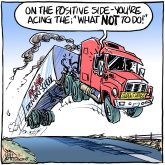Jobs, jobs, jobs
Over the next few months we will hear a great deal about Canada’s unemployment rate which has been hovering at about 10 percent for some years.
It seems an issue that will excite voters and so federal election candidates will thump it for all it’s worth.
We find the American average rate of joblessness has been running less than ours. Now that should spur us to action. We’d probably feel better if we compared Canada’s performance with Spain’s, where unemployment is 22 percent, but that won’t win any votes among those young people unable to find work.
Read Also

Rural communities can be a fishbowl for politicians, reporter
Western Producer reporter draws comparisons between urban and rural journalism and governance
Governments are faced with a dilemma. If they put policies in place to encourage businesses to establish and expand, there is initial benefit to the employment situation. Then businesses opt for reducing staff, using part-timers or contracting out component work. Inventive geniuses have discovered ways of replacing assembly lines of people with robots.
On the farm when I was young, hired men and women were part of the scenery and when harvest time came a crew of 14 or so would move in to thresh our grain. No more.
One way we could overtake the Americans is to copy part of their electoral system. They have congressional elections every two years. They elect their sheriffs, their district attorneys and a raft of other functionaries. All of this electoral activity creates employment for campaign managers, public relations people, pamphlet distributors, poster pasters, returning officers, poll clerks and go-fers.
It beats hiring people to dig a hole and then fill it in again.














